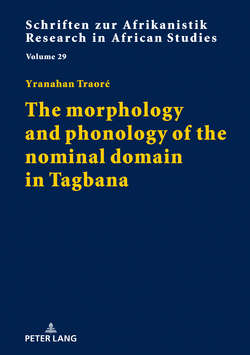Читать книгу The morphology and phonology of the nominal domain in Tagbana - Yranahan Traoré - Страница 10
На сайте Литреса книга снята с продажи.
ОглавлениеAbstract
In this book, I investigate the morphology and phonology of the nominal domain in Fròʔò (Tagbana), a Senufo language of Côte d’Ivoire, which has not yet been studied in detail; see Clamens (1957) and Miehe (2012) for Tagbana. The nominal domain is the locus of a phenomenon called ‘alliterative concord’, a special kind of concord expressed by consonantal alliteration. All dependent morphemes of a head noun share articulatory features, which are realized on the onset of the first syllable. They are abstract features signalling the class of the dependent morphemes.
The first aspect elaborated on, after introducing the language in Chapter 1, is the inventory of segments in the language. The theoretical framework in the sound description is the feature geometry as proposed by Kenstowicz (1994). Feature geometry is a phonological theory which represents distinctive features as a structured hierarchy rather than a matrix or a set, and it encodes groups of features under nodes in a tree. See McCarthy (1988) and Clements (1985). A feature geometric representation of the features accounts for natural classes, and it makes predictions about possible assimilation processes in the language.
Another aspect illustrated in Chapter 3 is syllable structure. Fròʔò has three underlying syllable structures: C(C)V, C(C)V: or V, where there is no underlying coda; but, C(C)VC syllables arise through final vowel deletion and liquid metathesis. The onset can be complex, although it is limited to two positions which are restricted in their order by the sonority sequence principle. In this chapter, it is also shown how the constraints on syllable structure repair loanwords in Fròʔò. The last process that is described is the fusion of two monosyllabic morphemes into a single syllable, and an optimality-theoretic account of the syllable structure is proposed at the end of the chapter.
Chapter 4 introduces simplex nouns and nominal classes. A noun in Fròʔò consists minimally of a lexical root and a class marker, which can be covert. There are seven classes in Fròʔò, six of which are organized by gender (pairs of corresponding singular and plural). Class 7 contains uncountable (mass) nouns, which have no plural.
In Chapter 5, an overview of alliterative concord is given, addressing work by Corbett (1991) and Hockett (1958) on the nominal domain. Each nominal class is identified in the phonology by a set of features that are reproduced in the initial consonant of each agreeing morpheme. In this chapter, I propose a morphological analysis of the functional morphemes in the framework of Distributed ←17 | 18→Morphology, with special attention to those standing in an agreement relation with the head noun (some, like numerals, are invariable). In the last part of the chapter, I examine the phonological processes that are needed following the morphology, and an optimality-theoretic analysis of the phonological processes is offered.
Chapter 6 discusses the derivational role of class markers (CM). The morphological form of a default noun in Fròʔò is a lexical root and a category-defining CM. The special CMs used with nominal roots are the CM3-CM4, leading to diminutives, the CM5-CM6, leading to augmentatives, and the CM7 for mass nouns or properties. Nouns can be also derived from a verbal root by suffixing a CM on that root, in a deverbalization process. Like denominalization, deverbalization consists of adding a CM to the verbal root. The same CMs as before can play this role: CM3-CM4, CM5-CV6, and CM7. The third process of noun formation involves adjectival roots. When the adjective has no head noun to agree with, it occurs in its citation form. In this case, only CM5 can be added, playing the role of default nominalizer. This process shows that the citation form of adjectives is preferably nominal. In a predicative construction, adjectives agree in the feature [CLASS] with the head nominal they modify, which is either a noun or a pronoun. In both cases, an adjective needs a class marker to stand on its own.
Chapter 7 describes compounding operations in the nominal domain, forming what is called a ‘complex noun’ which contains more than one lexical root. The term ‘complex noun’ is used to demarcate these words from the ‘simplex’ nouns consisting of only one lexical root and one CM. At least three kinds of nominal compounds are found in Fròʔò: complex nouns consisting of two or more nominal roots (N + N), compounds consisting of a nominal and a verbal root (N + V), and complex nouns consisting of a nominal and an adjectival root (N + A).
←18 | 19→
